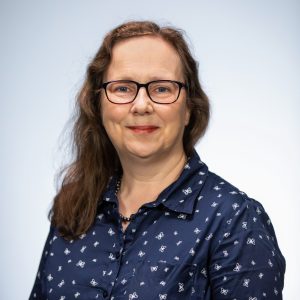
ASSOCIATE PROFESSOR KATHERINE SEATON
La Trobe University
We talk to Associate Professor Katherine Seaton about how she uses art to illustrate mathematical concepts and her passion for science communications.
1. If not mathematics research, what would have been?
I always say that mathematics, or mathematical physics in particular, found me. I really thought in the last few years of school that I wanted to study pharmacy, and work in a hospital. It turned out that what I really liked was chemistry, and what I really liked about chemistry was the calculations! I transferred into science from pharmacy, got credit for chemistry and so took only physics and maths for a year, and then I never went back! If I had to choose a new career now, it would probably be science communication, because outreach is one of the things I love doing in my job. But I like my current roles – Associate Professor and Mother – quite a lot, so I am not looking for a change right now.
2. If you could have any superpower what would it be? Rock star scientist, master chef, closet artist, what is something about you that might surprise people?
It’s not really a secret any more. I really like the fibre arts, such as knitting and crochet. As well as being relaxing, they provide a way to explore and illustrate mathematical concepts such as symmetries, topology and hyperbolic geometry. There is a school of feminist thought now about reclaiming these traditionally feminine crafts (which second wave feminism dropped) in order to acknowledge this kinaesthetic practice of scientific and mathematical ideas. But you might be surprised to know that I have won prizes for fibre art made out of plastic bags, and that I am on the editorial board of the Journal for Mathematics and the Arts. (You might even be surprised that there is such a journal!)
3. Deepening field knowledge and providing a networking platform, why are opportunities such as AMSI Summer School so valuable? What do you hope attendees take from your lectures?
There is a big temptation to teach the way that we were taught, or to assume that our students learn in the same way that we ourselves like to learn, or even that maths is taught in the same way at every university. But the people who become mathematicians are probably not the “typical” students in a large first year class. I really hope that attendees will start to think about how mathematics is learned, and their role as aspiring mathematicians in communicating it. Generic advice on university teaching doesn’t necessarily address mathematics very well, so at Summer School we will have a critical mass of future mathematics tutors, with slightly different learning experiences from their home institutions, and the chance to influence the next generation of tutors is one I relish.
4. If you could be anywhere right now, where would you be?
Right now, writing this in August in Melbourne, I wish I had just come back from the Bridges conference on Mathematics and the Arts, held this year in Linz (Austria) – but I didn’t go to it. I think what I like about maths and the arts people, and maths education people, is the genuine concern they have to communicate. They don’t want to necessarily dazzle with their brilliance, or to compel you with the logic, but to get you to understand.
Associate Professor Katherine Seaton will be presenting the topic Effective Teaching, Effective Learning in Quantitative Disciplines at the 2020 Summer School at La Trobe University in January

